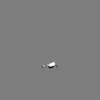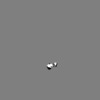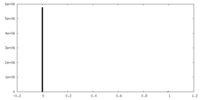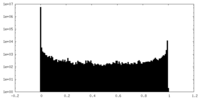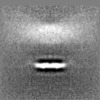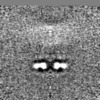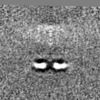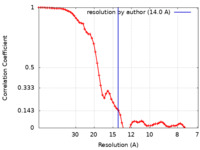+ データを開く
データを開く
- 基本情報
基本情報
| 登録情報 |  | ||||||||||||
|---|---|---|---|---|---|---|---|---|---|---|---|---|---|
| タイトル | Hexameric human IgG3 Fc complex | ||||||||||||
 マップデータ マップデータ | Subtomogram average of IgG3-Fc hexamer formed on lipid bilayers | ||||||||||||
 試料 試料 |
| ||||||||||||
 キーワード キーワード | IgG3 / antibody / Fc hexamer / IMMUNE SYSTEM | ||||||||||||
| 機能・相同性 |  機能・相同性情報 機能・相同性情報 | ||||||||||||
| 生物種 |  Homo sapiens (ヒト) Homo sapiens (ヒト) | ||||||||||||
| 手法 | サブトモグラム平均法 / クライオ電子顕微鏡法 / 解像度: 14.0 Å | ||||||||||||
 データ登録者 データ登録者 | Abendstein L / Sharp TH | ||||||||||||
| 資金援助 | European Union,  オランダ, 3件 オランダ, 3件
| ||||||||||||
 引用 引用 |  ジャーナル: Nat Commun / 年: 2023 ジャーナル: Nat Commun / 年: 2023タイトル: Complement is activated by elevated IgG3 hexameric platforms and deposits C4b onto distinct antibody domains. 著者: Leoni Abendstein / Douwe J Dijkstra / Rayman T N Tjokrodirijo / Peter A van Veelen / Leendert A Trouw / Paul J Hensbergen / Thomas H Sharp /  要旨: IgG3 is unique among the IgG subclasses due to its extended hinge, allotypic diversity and enhanced effector functions, including highly efficient pathogen neutralisation and complement activation. ...IgG3 is unique among the IgG subclasses due to its extended hinge, allotypic diversity and enhanced effector functions, including highly efficient pathogen neutralisation and complement activation. It is also underrepresented as an immunotherapeutic candidate, partly due to a lack of structural information. Here, we use cryoEM to solve structures of antigen-bound IgG3 alone and in complex with complement components. These structures reveal a propensity for IgG3-Fab clustering, which is possible due to the IgG3-specific flexible upper hinge region and may maximise pathogen neutralisation by forming high-density antibody arrays. IgG3 forms elevated hexameric Fc platforms that extend above the protein corona to maximise binding to receptors and the complement C1 complex, which here adopts a unique protease conformation that may precede C1 activation. Mass spectrometry reveals that C1 deposits C4b directly onto specific IgG3 residues proximal to the Fab domains. Structural analysis shows this to be caused by the height of the C1-IgG3 complex. Together, these data provide structural insights into the role of the unique IgG3 extended hinge, which will aid the development and design of upcoming immunotherapeutics based on IgG3. | ||||||||||||
| 履歴 |
|
- 構造の表示
構造の表示
| 添付画像 |
|---|
- ダウンロードとリンク
ダウンロードとリンク
-EMDBアーカイブ
| マップデータ |  emd_16227.map.gz emd_16227.map.gz | 1.1 MB |  EMDBマップデータ形式 EMDBマップデータ形式 | |
|---|---|---|---|---|
| ヘッダ (付随情報) |  emd-16227-v30.xml emd-16227-v30.xml emd-16227.xml emd-16227.xml | 16.3 KB 16.3 KB | 表示 表示 |  EMDBヘッダ EMDBヘッダ |
| FSC (解像度算出) |  emd_16227_fsc.xml emd_16227_fsc.xml | 8.3 KB | 表示 |  FSCデータファイル FSCデータファイル |
| 画像 |  emd_16227.png emd_16227.png | 179.5 KB | ||
| マスクデータ |  emd_16227_msk_1.map emd_16227_msk_1.map | 22.2 MB |  マスクマップ マスクマップ | |
| Filedesc metadata |  emd-16227.cif.gz emd-16227.cif.gz | 5.6 KB | ||
| その他 |  emd_16227_half_map_1.map.gz emd_16227_half_map_1.map.gz emd_16227_half_map_2.map.gz emd_16227_half_map_2.map.gz | 16.8 MB 17 MB | ||
| アーカイブディレクトリ |  http://ftp.pdbj.org/pub/emdb/structures/EMD-16227 http://ftp.pdbj.org/pub/emdb/structures/EMD-16227 ftp://ftp.pdbj.org/pub/emdb/structures/EMD-16227 ftp://ftp.pdbj.org/pub/emdb/structures/EMD-16227 | HTTPS FTP |
-検証レポート
| 文書・要旨 |  emd_16227_validation.pdf.gz emd_16227_validation.pdf.gz | 674.9 KB | 表示 |  EMDB検証レポート EMDB検証レポート |
|---|---|---|---|---|
| 文書・詳細版 |  emd_16227_full_validation.pdf.gz emd_16227_full_validation.pdf.gz | 674.5 KB | 表示 | |
| XML形式データ |  emd_16227_validation.xml.gz emd_16227_validation.xml.gz | 12.4 KB | 表示 | |
| CIF形式データ |  emd_16227_validation.cif.gz emd_16227_validation.cif.gz | 17.1 KB | 表示 | |
| アーカイブディレクトリ |  https://ftp.pdbj.org/pub/emdb/validation_reports/EMD-16227 https://ftp.pdbj.org/pub/emdb/validation_reports/EMD-16227 ftp://ftp.pdbj.org/pub/emdb/validation_reports/EMD-16227 ftp://ftp.pdbj.org/pub/emdb/validation_reports/EMD-16227 | HTTPS FTP |
-関連構造データ
- リンク
リンク
| EMDBのページ |  EMDB (EBI/PDBe) / EMDB (EBI/PDBe) /  EMDataResource EMDataResource |
|---|
- マップ
マップ
| ファイル |  ダウンロード / ファイル: emd_16227.map.gz / 形式: CCP4 / 大きさ: 22.2 MB / タイプ: IMAGE STORED AS FLOATING POINT NUMBER (4 BYTES) ダウンロード / ファイル: emd_16227.map.gz / 形式: CCP4 / 大きさ: 22.2 MB / タイプ: IMAGE STORED AS FLOATING POINT NUMBER (4 BYTES) | ||||||||||||||||||||||||||||||||||||
|---|---|---|---|---|---|---|---|---|---|---|---|---|---|---|---|---|---|---|---|---|---|---|---|---|---|---|---|---|---|---|---|---|---|---|---|---|---|
| 注釈 | Subtomogram average of IgG3-Fc hexamer formed on lipid bilayers | ||||||||||||||||||||||||||||||||||||
| 投影像・断面図 | 画像のコントロール
画像は Spider により作成 | ||||||||||||||||||||||||||||||||||||
| ボクセルのサイズ | X=Y=Z: 3.48 Å | ||||||||||||||||||||||||||||||||||||
| 密度 |
| ||||||||||||||||||||||||||||||||||||
| 対称性 | 空間群: 1 | ||||||||||||||||||||||||||||||||||||
| 詳細 | EMDB XML:
|
-添付データ
-マスク #1
| ファイル |  emd_16227_msk_1.map emd_16227_msk_1.map | ||||||||||||
|---|---|---|---|---|---|---|---|---|---|---|---|---|---|
| 投影像・断面図 |
| ||||||||||||
| 密度ヒストグラム |
-ハーフマップ: Half map of subtomogram average of IgG3-Fc hexamer...
| ファイル | emd_16227_half_map_1.map | ||||||||||||
|---|---|---|---|---|---|---|---|---|---|---|---|---|---|
| 注釈 | Half map of subtomogram average of IgG3-Fc hexamer formed on lipid bilayers | ||||||||||||
| 投影像・断面図 |
| ||||||||||||
| 密度ヒストグラム |
-ハーフマップ: Half map of subtomogram average of IgG3-Fc hexamer...
| ファイル | emd_16227_half_map_2.map | ||||||||||||
|---|---|---|---|---|---|---|---|---|---|---|---|---|---|
| 注釈 | Half map of subtomogram average of IgG3-Fc hexamer formed on lipid bilayers | ||||||||||||
| 投影像・断面図 |
| ||||||||||||
| 密度ヒストグラム |
- 試料の構成要素
試料の構成要素
-全体 : Fc domain of human IgG3
| 全体 | 名称: Fc domain of human IgG3 |
|---|---|
| 要素 |
|
-超分子 #1: Fc domain of human IgG3
| 超分子 | 名称: Fc domain of human IgG3 / タイプ: complex / ID: 1 / 親要素: 0 / 含まれる分子: all |
|---|---|
| 由来(天然) | 生物種:  Homo sapiens (ヒト) Homo sapiens (ヒト) |
-分子 #1: FLJ00385 protein (Fragment)
| 分子 | 名称: FLJ00385 protein (Fragment) / タイプ: protein_or_peptide / ID: 1 / コピー数: 6 / 光学異性体: LEVO |
|---|---|
| 由来(天然) | 生物種:  Homo sapiens (ヒト) Homo sapiens (ヒト) |
| 分子量 | 理論値: 23.768957 KDa |
| 組換発現 | 生物種:  Homo sapiens (ヒト) Homo sapiens (ヒト) |
| 配列 | 文字列: LGGPSVFLFP PKPKDTLMIS RTPEVTCVVV DVSHEDPEVQ FKWYVDGVEV HNAKTKPREE QFNSTFRVVS VLTVLHQDWL NGKEYKCKV SNKALPAPIE KTISKTKGQP REPQVYTLPP SREEMTKNQV SLTCLVKGFY PSDIAVEWES SGQPENNYNT T PPMLDSDG ...文字列: LGGPSVFLFP PKPKDTLMIS RTPEVTCVVV DVSHEDPEVQ FKWYVDGVEV HNAKTKPREE QFNSTFRVVS VLTVLHQDWL NGKEYKCKV SNKALPAPIE KTISKTKGQP REPQVYTLPP SREEMTKNQV SLTCLVKGFY PSDIAVEWES SGQPENNYNT T PPMLDSDG SFFLYSKLTV DKSRWQQGNI FSCSVMHEAL HNRFTQKSLS L UniProtKB: FLJ00385 protein |
-分子 #2: FLJ00385 protein (Fragment)
| 分子 | 名称: FLJ00385 protein (Fragment) / タイプ: protein_or_peptide / ID: 2 / コピー数: 6 / 光学異性体: LEVO |
|---|---|
| 由来(天然) | 生物種:  Homo sapiens (ヒト) Homo sapiens (ヒト) |
| 分子量 | 理論値: 23.782943 KDa |
| 組換発現 | 生物種:  Homo sapiens (ヒト) Homo sapiens (ヒト) |
| 配列 | 文字列: GPSVFLFPPK PKDTLMISRT PEVTCVVVDV SHEDPEVQFK WYVDGVEVHN AKTKPREEQF NSTFRVVSVL TVLHQDWLNG KEYKCKVSN KALPAPIEKT ISKTKGQPRE PQVYTLPPSR EEMTKNQVSL TCLVKGFYPS DIAVEWESSG QPENNYNTTP P MLDSDGSF ...文字列: GPSVFLFPPK PKDTLMISRT PEVTCVVVDV SHEDPEVQFK WYVDGVEVHN AKTKPREEQF NSTFRVVSVL TVLHQDWLNG KEYKCKVSN KALPAPIEKT ISKTKGQPRE PQVYTLPPSR EEMTKNQVSL TCLVKGFYPS DIAVEWESSG QPENNYNTTP P MLDSDGSF FLYSKLTVDK SRWQQGNIFS CSVMHEALHN RFTQKSLSLS P UniProtKB: FLJ00385 protein |
-実験情報
-構造解析
| 手法 | クライオ電子顕微鏡法 |
|---|---|
 解析 解析 | サブトモグラム平均法 |
| 試料の集合状態 | particle |
- 試料調製
試料調製
| 緩衝液 | pH: 7.4 / 詳細: PBS |
|---|---|
| 凍結 | 凍結剤: ETHANE |
- 電子顕微鏡法
電子顕微鏡法
| 顕微鏡 | FEI TECNAI ARCTICA |
|---|---|
| 撮影 | フィルム・検出器のモデル: GATAN K3 (6k x 4k) / 平均電子線量: 1.5 e/Å2 |
| 電子線 | 加速電圧: 200 kV / 電子線源:  FIELD EMISSION GUN FIELD EMISSION GUN |
| 電子光学系 | 照射モード: FLOOD BEAM / 撮影モード: BRIGHT FIELD / 最大 デフォーカス(公称値): 6.0 µm / 最小 デフォーカス(公称値): 3.0 µm |
| 実験機器 | 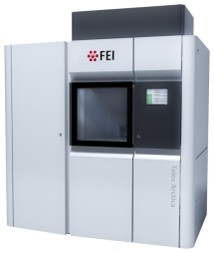 モデル: Talos Arctica / 画像提供: FEI Company |
 ムービー
ムービー コントローラー
コントローラー








 Z (Sec.)
Z (Sec.) Y (Row.)
Y (Row.) X (Col.)
X (Col.)








